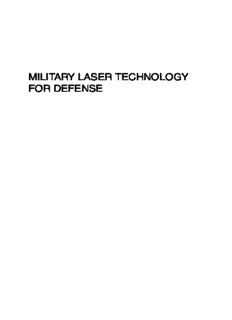
Military Laser Technology for Defense: Technology for Revolutionizing 21st Century Warfare PDF
Preview Military Laser Technology for Defense: Technology for Revolutionizing 21st Century Warfare
MILITARY LASER TECHNOLOGY FOR DEFENSE Military Laser Technology for Defense Technology for Revolutionizing 21st Century Warfare Alastair D. McAulay LehighUniversity,Bethlehem,PA Copyright©2011byJohnWiley&Sons,Inc.Allrightsreserved PublishedbyJohnWiley&Sons,Inc.,Hoboken,NewJersey PublishedsimultaneouslyinCanada Nopartofthispublicationmaybereproduced,storedinaretrievalsystem,ortransmittedinanyformor byanymeans,electronic,mechanical,photocopying,recording,scanning,orotherwise,exceptas permittedunderSection107or108ofthe1976UnitedStatesCopyrightAct,withouteithertheprior writtenpermissionofthePublisher,orauthorizationthroughpaymentoftheappropriateper-copyfeeto theCopyrightClearanceCenter,Inc.,222RosewoodDrive,Danvers,MA01923,(978)750-8400,fax (978)750-4470,oronthewebatwww.copyright.com.RequeststothePublisherforpermissionshould beaddressedtothePermissionsDepartment,JohnWiley&Sons,Inc.,111RiverStreet,Hoboken,NJ 07030,(201)748-6011,fax(201)748-6008,oronlineathttp://www.wiley.com/go/permission. LimitofLiability/DisclaimerofWarranty:Whilethepublisherandauthorhaveusedtheirbesteffortsin preparingthisbook,theymakenorepresentationsorwarrantieswithrespecttotheaccuracyor completenessofthecontentsofthisbookandspecificallydisclaimanyimpliedwarrantiesof merchantabilityorfitnessforaparticularpurpose.Nowarrantymaybecreatedorextendedbysales representativesorwrittensalesmaterials.Theadviceandstrategiescontainedhereinmaynotbesuitable foryoursituation.Youshouldconsultwithaprofessionalwhereappropriate.Neitherthepublishernor authorshallbeliableforanylossofprofitoranyothercommercialdamages,includingbutnotlimitedto special,incidental,consequential,orotherdamages. Forgeneralinformationonourotherproductsandservicesorfortechnicalsupport,pleasecontactour CustomerCareDepartmentwithintheUnitedStatesat(800)762-2974,outsidetheUnitedStatesat(317) 572-3993orfax(317)572-4002. Wileyalsopublishesitsbooksinavarietyofelectronicformats.Somecontentthatappearsinprintmay notbeavailableinelectronicformats.FormoreinformationaboutWileyproducts,visitourwebsiteat www.wiley.com. ISBN978-0-470-25560-5 LibraryofCongressCataloging-in-PublicationDataisavailable. PrintedinSingapore 10 9 8 7 6 5 4 3 2 1 CONTENTS PREFACE xiii ACKNOWLEDGMENTS xv ABOUT THE AUTHOR xvii I OPTICS TECHNOLOGY FOR DEFENSE SYSTEMS 1 1 OPTICALRAYS 3 1.1 ParaxialOptics / 4 1.2 GeometricorRayOptics / 5 1.2.1 Fermat’sPrinciple / 5 1.2.2 Fermat’sPrincipleProvesSnell’sLawforRefraction / 5 1.2.3 LimitsofGeometricOpticsorRayTheory / 6 1.2.4 Fermat’sPrincipleDerivesRayEquation / 6 1.2.5 UsefulApplicationsoftheRayEquation / 8 1.2.6 MatrixRepresentationforGeometricOptics / 9 1.3 OpticsforLaunchingandReceivingBeams / 10 1.3.1 ImagingwithaSingleThinLens / 10 1.3.2 BeamExpanders / 13 1.3.3 BeamCompressors / 14 1.3.4 Telescopes / 14 1.3.5 Microscopes / 17 1.3.6 SpatialFilters / 18 v vi CONTENTS 2 GAUSSIANBEAMSANDPOLARIZATION 20 2.1 GaussianBeams / 20 2.1.1 DescriptionofGaussianBeams / 21 2.1.2 GaussianBeamwithABCDLaw / 24 2.1.3 FormingandReceivingGaussianBeamswithLenses / 26 2.2 Polarization / 29 2.2.1 WavePlatesorPhaseRetarders / 31 2.2.2 StokesParameters / 33 2.2.3 Poincare´ Sphere / 34 2.2.4 FindingPointonPoincare´SphereandEllipticalPolarization fromStokesParameters / 35 2.2.5 ControllingPolarization / 36 3 OPTICALDIFFRACTION 38 3.1 IntroductiontoDiffraction / 38 3.1.1 DescriptionofDiffraction / 39 3.1.2 ReviewofFourierTransforms / 40 3.2 UncertaintyPrincipleforFourierTransforms / 42 3.2.1 UncertaintyPrincipleforFourierTransformsinTime / 42 3.2.2 UncertaintyPrincipleforFourierTransformsinSpace / 45 3.3 ScalarDiffraction / 47 3.3.1 Preliminaries:Green’sFunctionandTheorem / 48 3.3.2 FieldataPointduetoFieldonaBoundary / 48 3.3.3 DiffractionfromanAperture / 50 3.3.4 FresnelApproximation / 51 3.3.5 FraunhoferApproximation / 54 3.3.6 RoleofNumericalComputation / 56 3.4 Diffraction-LimitedImaging / 56 3.4.1 IntuitiveEffectofApertureinImagingSystem / 56 3.4.2 ComputingtheDiffractionEffectofaLensAperture onImaging / 57 4 DIFFRACTIVEOPTICALELEMENTS 61 4.1 ApplicationsofDOEs / 62 4.2 DiffractionGratings / 62 4.2.1 BendingLightwithDiffractionGratingsand GratingEquation / 63 4.2.2 CosinusoidalGrating / 64 4.2.3 PerformanceofGrating / 66 CONTENTS vii 4.3 ZonePlateDesignandSimulation / 67 4.3.1 AppearanceandFocusingofZonePlate / 67 4.3.2 ZonePlateComputationforDesignandSimulation / 68 4.4 Gerchberg–SaxtonAlgorithmforDesignofDOEs / 73 4.4.1 GoalofGerchberg–SaxtonAlgorithm / 73 4.4.2 InverseProblemforDiffractiveOpticalElements / 73 4.4.3 Gerchberg–SaxtonAlgorithmforForwardComputation / 74 4.4.4 Gerchberg–SaxtonInverseAlgorithmforDesigninga Phase-OnlyFilterorDOE / 74 5 PROPAGATIONANDCOMPENSATIONFOR ATMOSPHERICTURBULENCE 77 5.1 StatisticsInvolved / 78 5.1.1 Ergodicity / 79 5.1.2 LocallyHomogeneousRandomFieldStructureFunction / 80 5.1.3 SpatialPowerSpectrumofStructureFunction / 80 5.2 OpticalTurbulenceintheAtmosphere / 82 5.2.1 Kolmogorov’sEnergyCascadeTheory / 83 5.2.2 PowerSpectrumModelsforRefractiveIndexin OpticalTurbulence / 85 5.2.3 AtmosphericTemporalStatistics / 86 5.2.4 Long-DistanceTurbulenceModels / 86 5.3 AdaptiveOptics / 86 5.3.1 DevicesandSystemsforAdaptiveOptics / 86 5.4 ComputationofLaserLightThroughAtmosphericTurbulence / 89 5.4.1 LayeredModelofPropagationThrough TurbulentAtmosphere / 90 5.4.2 GenerationofKolmogorovPhaseScreensbythe SpectralMethod / 92 5.4.3 Generation of Kolmogorov Phase Screens from Covariance UsingStructureFunctions / 94 6 OPTICALINTERFEROMETERSANDOSCILLATORS 99 6.1 OpticalInterferometers / 100 6.1.1 MichelsonInterferometer / 101 6.1.2 Mach–ZehnderInterferometer / 105 6.1.3 OpticalFiberSagnacInterferometer / 108 6.2 Fabry–PerotResonators / 109 6.2.1 Fabry–PerotPrinciplesandEquations / 110 6.2.2 Fabry–PerotEquations / 110 viii CONTENTS 6.2.3 PiezoelectricTuningofFabry–PerotTuners / 116 6.3 Thin-FilmInterferometricFiltersandDielectricMirrors / 116 6.3.1 ApplicationsforThinFilms / 117 6.3.2 ForwardComputationThroughThin-FilmLayers withMatrixMethod / 118 6.3.3 InverseProblemofComputingParametersforLayers / 122 II LASER TECHNOLOGY FOR DEFENSE SYSTEMS 125 7 PRINCIPLESFORBOUNDELECTRONSTATELASERS 127 7.1 LaserGenerationofBoundElectronStateCoherentRadiation / 128 7.1.1 AdvantagesofCoherentLightfromaLaser / 128 7.1.2 BasicLight–MatterInteractionTheoryforGenerating CoherentLight / 129 7.2 SemiconductorLaserDiodes / 133 7.2.1 p–nJunction / 133 7.2.2 SemiconductorLaserDiodeGain / 136 7.2.3 SemiconductorLaserDynamics / 139 7.2.4 SemiconductorArraysforHighPower / 140 7.3 SemiconductorOpticalAmplifiers / 140 8 POWERLASERS 143 8.1 Characteristics / 144 8.1.1 Wavelength / 144 8.1.2 BeamQuality / 144 8.1.3 Power / 145 8.1.4 MethodsofPumping / 146 8.1.5 MaterialsforUsewithHigh-PowerLasers / 147 8.2 Solid-StateLasers / 148 8.2.1 PrinciplesofSolid-StateLasers / 148 8.2.2 FrequencyDoublinginSolidStateLasers / 150 8.3 PowerfulGasLasers / 158 8.3.1 GasDynamicCarbonDioxidePowerLasers / 158 8.3.2 COILSystem / 160 9 PULSEDHIGHPEAKPOWERLASERS 165 9.1 SituationsinwhichPulsedLasersmaybePreferable / 165 9.2 Mode-LockedLasers / 167 CONTENTS ix 9.2.1 Mode-LockingLasers / 167 9.2.2 MethodsofImplementingModeLocking / 169 9.3 Q-SwitchedLasers / 170 9.4 SpaceandTimeFocusingofLaserLight / 171 9.4.1 SpaceFocusingwithArraysandBeamforming / 171 9.4.2 ConcentratingLightSimultaneouslyinTime andSpace / 173 10 ULTRAHIGH-POWERCYCLOTRONMASERS/LASERS 177 10.1 IntroductiontoCyclotronorGyroLasers andMasers / 178 10.1.1 StimulatedEmissioninanElectronCyclotron / 178 10.2 Gyrotron-TypeLasersandMasers / 179 10.2.1 PrinciplesofElectronCyclotronOscillators andAmplifiers / 180 10.2.2 GyrotronOperatingPointandStructure / 182 10.3 VircatorImpulseSource / 184 10.3.1 RationaleforConsideringtheVircator / 184 10.3.2 StructureandOperationofVircator / 184 10.3.3 SelectingFrequencyofMicrowaveEmissionfrom aVircator / 186 10.3.4 MarxGenerator / 186 10.3.5 DemonstrationUnitofMarxGeneratorDriving aVircator / 188 11 FREE-ELECTRONLASER/MASER 191 11.1 SignificanceandPrinciplesofFree-Electron Laser/Maser / 192 11.1.1 SignificanceofFree-ElectronLaser/Maser / 192 11.1.2 PrinciplesofFree-ElectronLaser/Maser / 192 11.2 ExplanationofFree-ElectronLaserOperation / 193 11.2.1 WavelengthVersatilityforFree-ElectronLaser / 194 11.2.2 ElectronBunchingforStimulatedEmissionin Free-ElectronLaser / 197 11.3 DescriptionofHigh-andLow-PowerDemonstrations / 199 11.3.1 ProposedAirborneFree-ElectronLaser / 199 11.3.2 DemonstrationofLow-PowerSystemfor Free-ElectronMaserat8–12GHz / 200 11.3.3 AchievingLowFrequencieswithFELs / 200 x CONTENTS 11.3.4 RangeofTuning / 203 11.3.5 DesignofMagneticWiggler / 203 III APPLICATIONS TO PROTECT AGAINST MILITARY THREATS 205 12 LASERPROTECTIONFROMMISSILES 207 12.1 ProtectingfromMissilesandNuclear-TippedICBMs / 208 12.1.1 IntroducingLaserstoProtectfromMissiles / 208 12.1.2 ProtectingfromNuclear-TippedICBMs / 209 12.2 TheAirborneLaserProgramforProtectingfromICBMs / 212 12.2.1 LasersinAirborneLaser / 212 12.2.2 IncorporatingAdaptiveOpticsforMainBeamCleanup intoAirborneLaser / 213 12.2.3 IncorporatingAdaptiveOpticstoCompensatefor AtmosphericTurbulenceinABL / 215 12.2.4 IlluminatingLasersforSelectingTargetAimPoint / 215 12.2.5 NoseTurret / 217 12.2.6 ChallengesEncounteredintheABLProgram / 217 12.2.7 ModelingAdaptiveOpticsandTrackingfor AirborneLaser / 219 12.3 ProtectingfromHomingMissiles / 223 12.3.1 ThreattoAircraftfromHomingMissiles / 223 12.3.2 OverviewofOn-AircraftLaserCountermeasureSystem / 224 12.3.3 OperationofCountermeasureSubsystems / 227 12.3.4 ProtectingAircraftfromGround-BasedMissiles / 228 12.4 ProtectingAssetsfromMissiles / 228 13 LASERTOADDRESSTHREATOFNEWNUCLEARWEAPONS 231 13.1 LaserSolutiontoNuclearWeaponsThreat / 231 13.1.1 MainPurposeofU.S.andInternationalEfforts / 231 13.1.2 BenefitsofMassiveLaserProject / 232 13.1.3 AbouttheNIFLaser / 232 13.2 DescriptionofNationalInfrastructureLaser / 233 13.2.1 StructureoftheNIFLaser / 233 14 PROTECTINGASSETSFROMDIRECTEDENERGYLASERS 237 14.1 LaserCharacteristicsEstimatedbyLaserWarningDevice / 238 14.2 LaserWarningDevices / 239 CONTENTS xi 14.2.1 GratingforSimultaneouslyEstimatingDirection andFrequency / 240 14.2.2 LensforEstimatingDirectionOnly / 242 14.2.3 FizeauInterferometer / 243 14.2.4 IntegratedArrayWaveguideGratingOpticChipfor SpectrumAnalysis / 245 14.2.5 DesignofAWGforLaserWeapons / 249 15 LIDARPROTECTSFROMCHEMICAL/BIOLOGICAL WEAPONS 251 15.1 IntroductiontoLidarandMilitaryApplications / 252 15.1.1 OtherMilitaryApplicationsforLidar / 252 15.2 DescriptionofTypicalLidarSystem / 253 15.2.1 Laser / 253 15.2.2 CassegrainTransmit/ReceiveAntennas / 254 15.2.3 ReceiverOpticsandDetector / 254 15.2.4 LidarEquation / 255 15.3 Spectrometers / 257 15.3.1 Fabry–Perot-BasedLaboratoryOpticalSpectrum Analyzer / 258 15.3.2 Diffraction-BasedSpectrometer / 258 15.3.3 GratingOperationinSpectrometer / 260 15.3.4 GratingEfficiency / 261 15.4 SpectroscopicLidarSensesChemicalWeapons / 262 15.4.1 TransmissionDetectionofChemicaland BiologicalMaterials / 262 15.4.2 ScatteringDetectionofChemicalandBacteriological WeaponsUsingLidar / 263 16 94GHzRADARDETECTS/TRACKS/IDENTIFIESOBJECTS INBADWEATHER 265 16.1 PropagationofElectromagneticRadiationThroughAtmosphere / 266 16.2 High-ResolutionInclementWeather94GHzRadar / 267 16.2.1 94GHzRadarSystemDescription / 267 16.2.2 GyroklystronwithQuasi-OpticalResonator / 269 16.2.3 OvermodedLow94GHzLossTransmissionLine fromGyroklystrontoAntenna / 271 16.2.4 Quasi-OpticalDuplexer / 272 16.2.5 Antenna / 273 16.2.6 DataProcessingandPerformance / 273
Description: